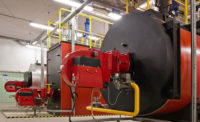A typical load profile for a hospital might show heat energy increases in the winter, with electric demand peaks in the summer as seen in Figures 1 and 2.
This hospital will save well over $500,000 per year by weaving tri-generation (heat, cooling, and power) into its central plant infrastructure. Tri-gen for this hospital will provide a simple payback of less than seven years when the avoided cost of replacing an old chiller with a new DX chiller is included. Add the avoided cost of an emergency generator and/or boiler, and the payback drops even more.
Tri-gen is a form of energy distribution that is integrated into the facility’s thermal and electrical infrastructure. Tri-gen will provide at least a portion of the electrical load, and provide thermal energy for space heating, space cooling, and dehumidification. Key benefits:
-
Tri-gen is more efficient than separate generation of electricity, cooling, and heating.
-
Higher efficiency translates to lower operating cost.
-
Higher efficiency reduces emissions of all pollutants.
-
Tri-gen can also increase energy reliability and enhance power quality, providing energy resilience for your critical infrastructure.
-
On-site electric generation reduces grid congestion and avoids distribution costs.
LEED support of absorption chillers
Tri-gen provides a significant impact to scoring LEED points (www.usgbc.org). The U.S. Green Building Council has a sample table showing how much CHP and CCHP are valued.
Absorption chillers use low-global warming and ozone-safe natural refrigerants (existing in nature) like R717 (NH3) and R744 (CO2), water and air, which are promoted through the LEED certification program, ASHRAE, EPA, DOE, and GSA. CHP can be shown to offer five to nine LEED points.
Even for these very small units, we can get six or more LEED points. But add in absorption chillers, and you can add more LEED points to your designs.
Absorption Chillers
Combined heat and power (CHP) is tremendously more efficient than traditional methods of serving your facility with separate electric generation and separate boilers for heat loads. However, adding absorption chillers takes the design up a significant notch. Adding absorption chillers allow the prime mover to operate at peak performance all year long.
Absorption or adsorption chillers can be incorporated into the existing central mechanical plant operations in multiple ways:
-
Waste heat application (allowing the boiler to operate at higher efficiency in the summer)
-
Part of a combined cooling, heat, and power (CCHP or tri-generation) application
-
As a standalone gas-fired absorption chiller application
An obvious example of a waste heat application is a case involving an absorption chiller where steam boilers need to operate during the summer at a load less than the minimum capacity, even with a modulating burner. Under this mode of operation, the boilers need to vent unused heat to the atmosphere. However, if an absorption chiller is added to the infrastructure, the excess capacity could be used to generate chilled water basically for free, allowing the boilers to operate at a more efficient level.
CCHP is ideal for locations where the electric utility imposes a “time of use” rate schedule. These rate schedules usually impose a higher cost for power in August during daytime hours. This is because most buildings have DX chillers or air conditioners, and that fact tends to max out the utility’s ability to meet the electric demand. Converting to absorption chillers would benefit your facility and the local power distribution in your community by:
-
Reducing energy costs
-
Stabilizing risks associated with fluctuating energy costs
-
Improving equipment reliability
-
Reducing greenhouse gas emissions by up to 50%
-
Reducing grid congestion
-
Reducing electrical demand charges
-
Providing reliable power supply
Absorption chillers can also be set up to use renewable solar as the heat source for the refrigeration cycle. Figure 3 depicts absorption chillers installed in climates where the sun typically shines when there is a need for space cooling or refrigeration. Of course, a boiler can be installed in parallel to support the cooling/refrigeration load during non-sunny days.
Typical electrical interconnection
A typical configuration for electrical interconnection is referred to as synchronous with paralleling switchgear. This configuration will allow for standalone use with or without utility backup.
Basically, during a grid outage, service disconnects but the generator continues to operate. During a generator outage, it will trip offline but power will still be supplied by the grid. The synchronous configuration is self-excited (does not need grid to operate), can assist in PF correction, will continue to operate through grid outages, and is more complicated and costly to interconnect. However, it is more preferred by CCHP customers. This configuration is popular where the generator is sized to meet your emergency loads.
Often, a generator sized to meet the thermal load is more than adequate to meet the emergency electric loads. Therefore, more equipment can be operational during a power outage beyond what is required per code.
What do the building codes say?
The building codes explicitly allowed natural gas cogen/trigen as an alternative to diesel. When your emergency equipment is part of your normal building operations, it is significantly more reliable, in addition to the other CCHP benefits discussed. What do the codes say?
The NFPA 99 defines: Uses for Essential Electrical Systems
6.4.1.1.7.1 - The generating equipment used shall be either reserved exclusively for such service or normally used for other purposes of peak demand control, internal voltage control, load relief for the external utility, or cogeneration.
The NFPA 110.5.1 defines: Energy sources
5.1.1* The following sources shall be permitted to be used for the emergency power supply (EPS):
-
Liquid petroleum products at atmospheric pressure as specified in the appropriate ASTM standards and as recommended by the engine manufacturer
-
Liquefied petroleum gas (liquid or vapor withdrawal) as specified in the appropriate ASTM standards and as recommended by the engine manufacturer
*Natural or synthetic gas
The National Electric Code Article 700 & 701define: Emergency and Standby Fuel
Article 700-12 (b)(3) Dual Supplies. Prime movers shall not be solely dependent on a public utility gas system for their fuel supply or municipal water supply for their cooling systems. Means shall be provided for automatically transferring from one fuel supply to another where dual fuel supplies are used.
Exception: Where acceptable to the authority having jurisdiction, the use of other than on-site fuels shall be permitted where there is a low probability of a simultaneous failure of both the off-site fuel delivery system and power from the outside electrical utility company.
So, what is the definition of “low probability of simultaneous failure”? The Center for Medicare and Medicaid Services (CMS) has addressed this. The CMS is the regulatory agency for the MOST regulated sector — health care. And, they put out a document that stated “We never intended to not allow natural gas generators.” Source: CMS 2009 (http://chfs.ky.gov/NR/rdonlyres/4C745EDB-C9D8-4AA9-B111-38092C60EFB4/0/NaturalGasGenerators.pdf). It’s requested that you would submit a Natural Gas Generator Reliability Letter. The requirements of this letter are:
-
A statement of reasonable reliability of the natural gas delivery.
-
A brief description that supports the statement regarding the reliability.
-
A statement that there is a low probability of interruption of the natural gas.
-
A brief description that supports the statement regarding the low probability of interruption.
-
The signature of technical personnel from the natural gas vendor.
The CMS even wrote a sample letter of their expectations to make it easy to submit.
CASE STUDIES
An example of a facility that incorporated absorption chillers is the Lake Forest Hospital in Illinois. This hospital is saving $640,000 per year in energy.
Another example of a hospital that made the conversion to CCHP is Cooley Dickinson Health Care in Massachusetts. This hospital, however, took their design up a significant notch and practically eliminated its carbon footprint by installing a biomass CCHP system. Since biomass is a renewable resource, this hospital is situated to really rake in the bucks when we get hit with carbon taxes. This hospital will have carbon credits to sell, making their central plant a revenue generator.
A third example is a site that has been in operation for over a decade, giving credence to the fact that CCHP is a mature technology that the next generation of engineers will weave into all their future designs to one degree or another. It may only be a 25kW unit, or it may be a 25MW system. But, the designs of the future will regularly incorporate CCHP.
Is your site a good candidate for absorption chillers?
What are some key questions that indicate whether your site is a good candidate for tri-gen, co-gen, and/or absorption chillers in general?
-
Is there a use for the CHP waste/recycled heat?
-
Is there a major rehab or thermal equipment change planned?
-
Is there sufficient “spark spread”? To make this determination: Obtain the prior 12 months electric and gas utility bills. Determine average annual electric cost ($/MMBtu). Determine average gas cost ($/MMBtu). Calculating the gas/electric price difference = spark spread. CHP has more potential for favorable payback when the spark spread is greater than $12/MMBtu.
-
Are there potential installation issues that make it too expensive?
-
Is there a need for high power and thermal reliability?
-
Is there concern over future electricity prices?
-
Is there interest in reducing environmental impact?
-
Is there an existing central plant?
-
Do you plan a facility expansion or new construction; or equipment replacement within the next three to five years?
Any of these questions can be a motivator to consider absorption chillers at your facility.
Where do I start?
The U.S. DOE CHP Technical Assistance Partnership (TAP) has a mission to support your efforts to reduce pollution, improve power reliability, and extend the life of our non-renewable resources. They are available to do so in the following ways:
-
Provide stakeholders with the resources necessary to identify and pursue CCHP market opportunities.
-
Support implementation of CCHP systems in both standalone and district energy and/or microgrid with CCHP settings.
-
CHP TAPs, as regional CHP experts, are critical components of achieving the goal by:
- Providing fact-based, unbiased information on CHP
- Educating on technologies
- Assisting with project development
- Connecting you with potential project financing options
- Acting as local electric and natural gas interfaces
- Promoting state best practice policies
- Remaining vendor, fuel, and technology neutral
- Providing education and outreach
The U.S. DOE CHP TAP provides information on the energy and non-energy benefits and applications of CHP to state and local policy makers, regulators, endusers, trade associations, and others. They are there to provide technical assistance and explore market opportunities.
Technical Assistance
TAP personnel are available to provide technical assistance to endusers and stakeholders to help them consider CHP, waste heat to power, and/or district energy with CHP in their facility and to help them through the development process from initial CHP screening to installation. Some of the functions offered include:
-
Electrical load profiling
-
Thermal load profiling
-
Unit sizing
-
Thermal use determination (what to do with the heat)
-
Installation cost estimations
-
Financial calculations (simple payback, ROI, etc.)
-
Cost/savings information compared to what your facility would pay if the CHP system were not installed
Market Opportunity Analysis
TAP can also support analyses of CHP market opportunities in diverse markets including industrial, federal, institutional, and commercial sectors.
No-cost screening and other technical assistance from the CHP TAP can be obtained from your regional member as found in the Figure 5.
SUMMARY
Weaving absorption chillers into your designs will benefit your customers. You will be providing a design that reduces operating costs. Your customer’s environmental footprint will be reduced, resulting in cleaner air for their community. And designs with CCHP can offer the most efficient power and thermal generation technologies. CCHP is a proven technology, commercially available to cover a full range of sizes and applications. Two other articles on the technology and value of absorption chillers are available at these links (quick registration is required to view the ES archives):
http://www.esmagazine.com/articles/97567-absorption-chillers-for-institutional-occpancies
http://www.esmagazine.com/articles/97665-data-centers-abadsorption-chillers












